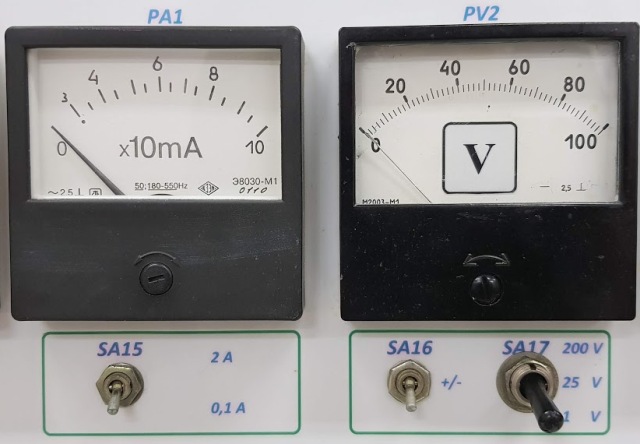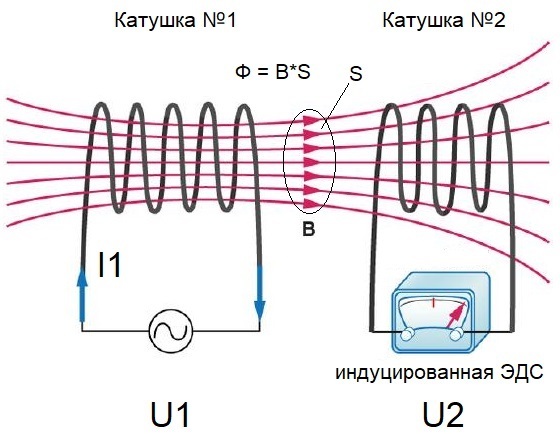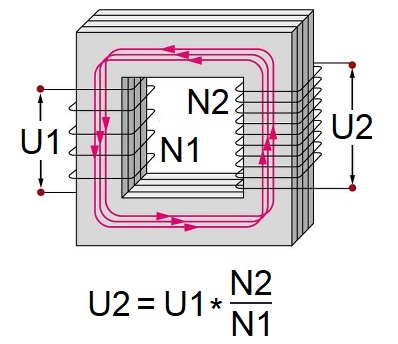Categories: Featured Articles » Novice electricians
Number of views: 3501
Comments on the article: 0
How voltage is converted to current
It is impossible to turn current into voltage or voltage into current, since these are fundamentally different phenomena. Voltage is measured at the ends of a conductor or an EMF source, while current is an electric charge moving through a cross section of a conductor.
Voltage or current can only be converted into voltage or current of a different magnitude, in this case they talk about the conversion of electrical energy (power).

If the voltage decreases during the conversion of electrical energy, then the current rises, and if the voltage rises, then the current decreases. The amount of energy at the input and output will be approximately the same (minus, of course, the loss in the conversion process) in accordance with the law of conservation of energy.
This is because the electrical energy A is initially the potential energy (position energy in an electric field) of an electric charge, that is, A = U * q. And the current I - is nothing more than the movement of the charge q in the electric field over time t, that is, I = q / t.
Therefore, in the process of converting energy A1 = U1 * q1 at the input - into energy A2 = U2 * q2 at the output of a certain converting device - either the potential difference (U2 Or the amount of charge transferred per unit time decreases (q2 To carry out such a conversion of electric energy, they use the phenomenon of electromagnetic induction, discovered by Michael Faraday in late summer 1831, and used today in transformers and in pulse voltage converters to reduce or increase voltage (respectively, to increase or decrease current). Next, we consider the process of such a transformation in general terms. When the current I changes (increases and decreases) in a conducting coil with inductance L — the magnetic field B generated by this current and penetrating the area S limited by this coil changes — the magnetic flux Φ = B * S = L * I. How quickly the current I in the coil changes — so does the magnetic flux Φ, permeating the area S limited by this coil. The alternating current I in the coil is directly proportional to the voltage U applied to the ends of the coil. Thus, the larger the amplitude U, the greater the amplitude of the current I in the coil and the greater the amplitude of the magnetic flux Φ of the coil with the current. Michael Faraday showed that a time-varying magnetic flux is capable of inducing EMF (voltage) in a circuit covering the region of this varying magnetic flux, and the rate of change of the magnetic flux dF / dt affects the magnitude of the resulting EMF: the higher the rate of change of the magnetic flux, the higher is the voltage at the ends of the circuit. Consequently, if we place another coil (secondary) in the range of the changing magnetic flux, then an EMF (voltage at the ends) will be induced in it, proportional to the rate of change of the magnetic flux — the greater the magnetic flux and the faster it changes — the greater the induction in the secondary coil EMF. If there are several (N) secondary turns and they are connected in series, then the induced EMF will add up in them. And if the secondary circuit is closed, then the charge (current) moved along it will create its own magnetic flux, opposite to the primary magnetic flux in direction and equal in magnitude to it. If the turns of the secondary circuit are completely similar to the primary turn in magnetic properties, shape, and inductance, then in this case the current caused by the induced EMF will be divided equally among all the secondary turns. Therefore, the more turns connected in series - the more voltage is obtained at the output and the less current will be at the output when the circuit is closed to the load. It works on this principle transformerincreasing or decreasing alternating voltage and, accordingly, decreasing or increasing alternating current. If there are more primary turns and less secondary ones, then there will be more current per turn of the secondary coil, but the voltage at the ends of the secondary coil will be less in total (proportional to the ratio of turns in the windings), that is, the output current will increase compared to the input, and the voltage will go down.



See also at i.electricianexp.com
:
